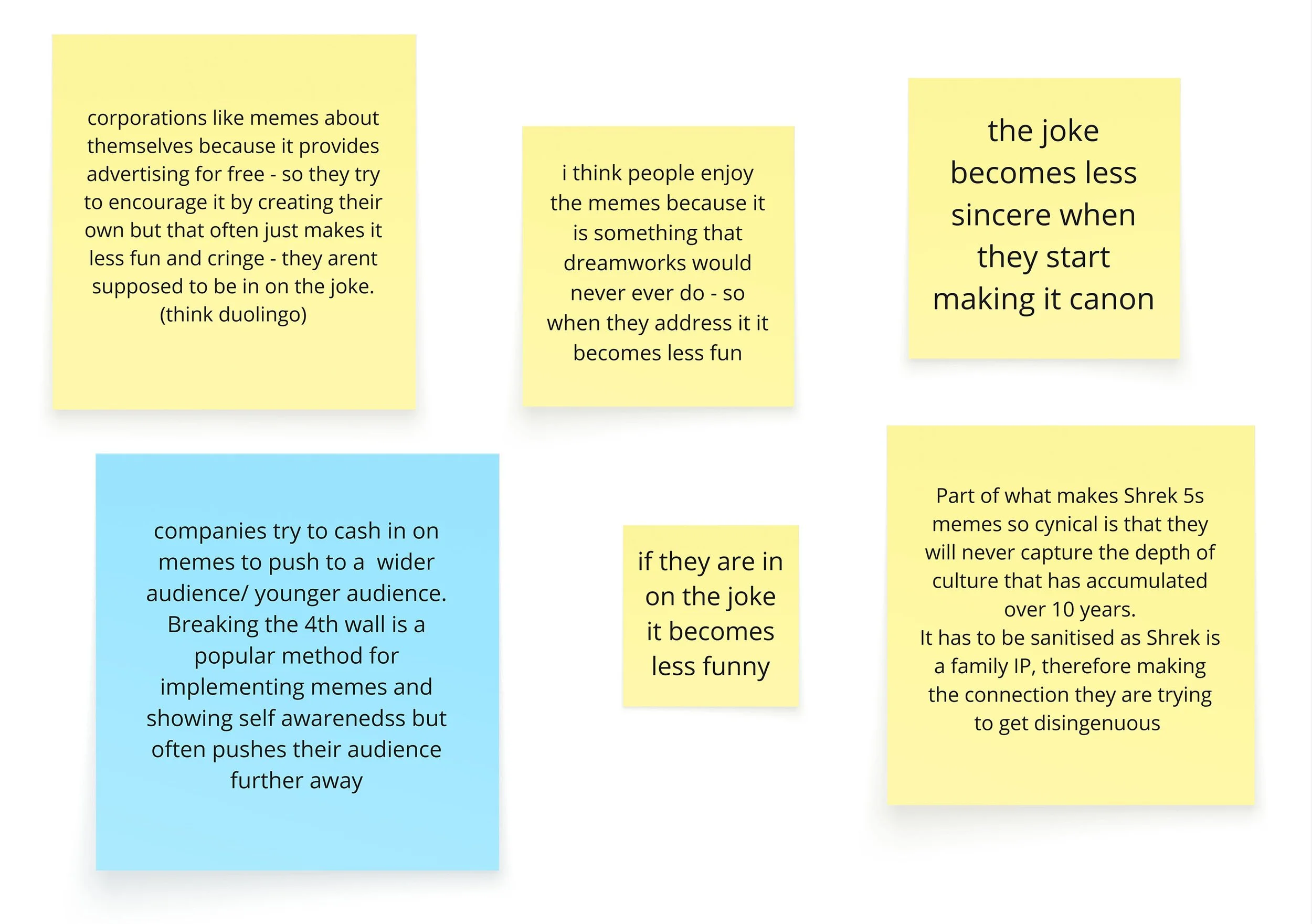Get Shreked! On Reverse Lectures, Memes, Metamodernism and Meaning-Making
Theory in Practice
I’ve been running a series of lectures at Norwich University of the Arts under the heading of "Big Ideas”. These are designed to be short, accessible introductions to different strands of critical theory and how they intersect with creative practice, particularly within animation and VFX. This session began like the others, with a critical idea I wanted to introduce: metamodernism.
To fully explore the sometimes slippery concept of oscillation between irony and sincerity, between the critical distance of postmodernism and the heartfelt optimism of modernism, we also needed to revisit modernism and postmodernism, what they’ve meant for art and culture, and how they’ve shaped contemporary creative practice.
As the last talk in the series, rather than a conventional lecture I wanted to break the format and create an environment in which the students could collaboratively find their own meaning and their own understanding of the topics. The result was a kind of reverse lecture, scaffolded through a Miro board, anchored by memes, and centred on the gloriously unhinged fan project Shrek Retold.
Why Shrek?
The catalyst was a short scene from Shrek Retold a crowdsourced fan-made reimagining of the original film, stitched together by hundreds of creators led by Grant Duffrin. The specific clip featured David Liebe Hart solemnly covering Leonard Cohen’s Hallelujah, using a badly made Shrek puppet.
It’s absurd. It’s earnest. It’s strangely moving. The debate in the youtube comments seems fascinated with the ballance between irony and sincerity. It felt like metamodernism in miniature.
From this starting point Shrek Retold also opened up conversations about authorship, fan culture and the internet’s unique capacity for remix, recuperation, and the social construction of meaning.
Flipping the Lecture
Inspired by the idea of a flipped classroom, instead of a traditional delivery I created a reverse lecture in which the answers and meaning could emerge collaboratively through discussion, sharing of ideas, quickfire research and moments of chaos. Here’s how it worked:
I scaffolded a Miro board as a conceptual map, with clusters of linked topics: metamodernism, authorship, fan culture, recuperation, meaning-making, and meme culture.
I seeded the board with prompts, key thinkers, and research tasks, leaving large areas empty.
I distributed five laptops in the lecture theatre and invited students to research, respond, and build out the board live.
At key points, I jumped into a Vevox poll to get instant reactions to key points and open up further discussion.
The aim was to mirror the messiness of meaning-making, treating the lecture not as transmission, but as collaborative construction.
Controlled Chaos
The session quickly became noisy, playful, and high-energy. Students joined the Miro board from phones as well as the laptops, posting memes, commentary, and references. Images flew across the screen. Some ideas spiralled. Others got buried. Occasionally I had to pull things back and step back into the traditional lecturer role to ask a clarifying question or reorient the discussion.
There was a clear energy exchange happening. I was working hard to keep things on task without shutting down the enthusiasm and amongst the memes and the chatter there were flashes of real insight.
A standout discussion focused on recuperation: how DreamWorks appears to be reclaiming Shrek memes for marketing (Shrek 5’s trailer leans directly into meme culture). Students debated whether this was a cynical rebranding or an acknowledgment of fan authorship. They engaged sincerely with how this changed their own relationship to the memes, addressing questions of corporate co-option, meme communities, and the emotional weight of “low culture.”
Students’ thoughts on the use of fan-created memes within Shrek 5 promotional material, 2025
What Did They Learn?
This was the big question I asked myself after the session. Amidst the noise and laughter and the transgressive joy of plastering Shrek memes all over your lecturer’s carefully prepared session, what actually landed?
I think (I hope) they came away with this:
That critical theory isn’t separate from pop culture. It can be applied directly to the things they already care and know about.
That authorship is complex, especially within remix culture and fandoms.
That meaning is socially constructed, and participating in its construction is both messy and powerful.
That something apparently trivial can be culturally rich and worthy of thoughtful attention.
It wasn’t neat. But it was live. And for a discussion of metamodernism and meaning-making, that felt fitting.
Reflections on the Format
Would I use this format again? Absolutely, but with adjustments.
I tried to cover a few too many concepts. Next time I’d reduce the scope and go deeper.
The energy in the room was electric, but maybe too much for quieter students. I’d look at ways to scaffold quieter engagement and encourage equal participation.
This experiment is part of a wider effort I’ve been making to embed critical theory more directly into creative practice. I aim to show students that analysis isn’t just something to be done after making, but that it’s something that can be in constant dialogue with a making process, and can inform, energise, and complicate their creative work.
Tier list of Shrek memes as ordered by the participants, 2025
The Messiness of Meaning Making
I think the most successful part of the reverse lecture was in one of the central ideas we discussed, that meaning is socially constructed. This concept was being enacted in the session itself. The reverse lecture didn’t just talk about meaning-making; it became an instance of it. A chaotic, co-authored space where interpretation, culture, fandom and theory collided. The lecture was never mine alone. The students helped build it, derail it, reframe it.
In that sense, the session was the message. Students are not just consumers of knowledge, or of culture, but collaborators and co-authors.

